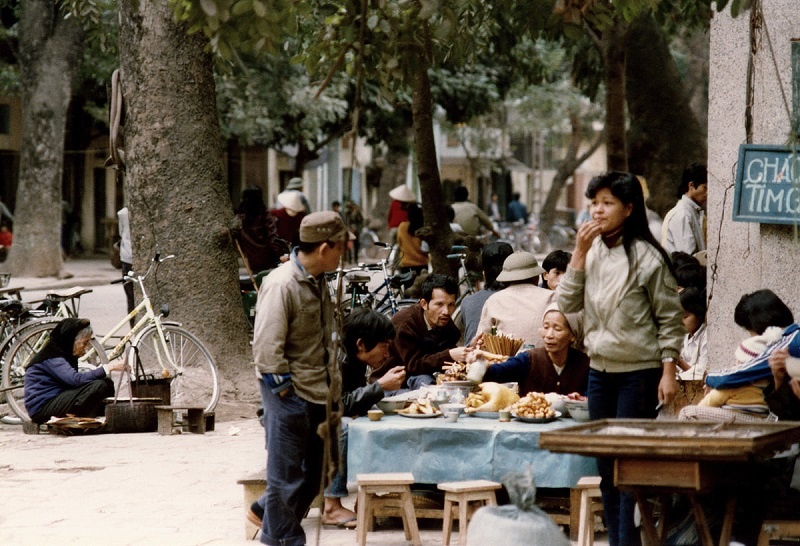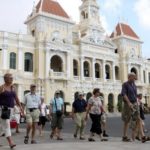In accordance with conventional norms, a sidewalk typically serves as a pathway for pedestrians, as well as accommodating vegetation and critical urban infrastructures, like electric poles and lights. However, for numerous residents of Hanoi, particularly those residing in the Old Quarter Area, the sidewalk holds a nostalgic and irreplaceable significance in their daily lives.
A vibrant and inviting space designed for socializing and connecting with others. Our establishment offers a plethora of exciting activities and events that are perfect for mingling with friends and meeting new people. Join us for a fun and engaging experience where you can create lasting memories and make meaningful connections. Come and discover our interesting space for socializing!
| Hanoi sidewalks in the 1990s: A place for gathering. File Photo |
According to author Do Phan, in 1969, following the end of American bombing and the return of evacuated students to Hanoi, the sidewalks became playgrounds for children.
During recess, the sidewalk in front of the school gates would be filled with students and vendors selling a variety of snacks such as dry apricot, roasted peanuts, apple mix, crispy dumplings, and candy balls. Some boys would be playing soccer or kicking shuttlecocks, while the girls would be skipping rope or playing mandarin square capturing. Outside of school hours, children would also be seen riding bicycles or climbing trees to pick tamarinds and dragon plums.
Nguyen Van Huy, the Deputy Director at the Vietnam Center for Research and Promotion of Cultural Heritage, presented an explanation to The Hanoi Times, stating that the tradition of Hanoians gathering on the sidewalk for tea and conversations remains a prevalent aspect of their daily lives.
According to Dr. Nguyen Thi Phuong Cham, a researcher at the Institute of Cultural Studies under the Vietnam Academy of Social Sciences, the sidewalks in downtown Hanoi serve as a vibrant social hub. Notably, areas such as Le Van Huu, Thi Sach, Ngo Thi Nham, Tran Xuan Soan, Lo Duc, and Hoa Ma are frequented by laborers and street vendors who utilize them as cooking and resting spaces. It is common to see these individuals laying down a sheet or sack to take a short 15-minute nap before returning to their work duties.
The source of livelihood of many families
| A family enjoyed Pho Thin or Thin’s Beef Noodle Soup on the sidewalk of Dinh Tien Hoang Street, Hoan Kiem District, Hanoi. Photo: Hieu TK |
In the era of centrally-planned economy, particularly from 1989 to 1991, the sidewalks of Hanoi became a vibrant hub for livelihood, reminiscent of the bustling old ‘Ke Cho’ area in Thang Long (an old name for Hanoi, meaning ‘urban area’). This was attributed to the substantial restructuring of the public sector during that time, which resulted in numerous civil servants and workers being forced into early retirement without sufficient financial resources or land. Consequently, they had to find work outside their areas of expertise.
According to author Nguyen Ngoc Tien, there was a societal trend captured in a folk song: “Colonels inflating tires at the street corners / Majors selling black bean sweet dessert soup in the middle of the sidewalk.”
Temporary markets thrived on the sidewalks, offering a convenient shopping experience for customers who could easily access them without the need for parking. Additionally, these markets provided more affordable prices for their goods since they were not subject to taxation like formal marketplaces. Pham Xuan Hop, a 50-year-old resident of Dong Da District, fondly recalls the vibrant atmosphere of the 1990s, where sidewalk vendors would serve delectable dishes such as sticky rice with mung bean, pork bone congee porridge, and duck embryos.
“As parents rushed to get to work on time, children, still groggy from waking up early, quickly finished their breakfast and hurried off to school. The streets grew quiet once again after breakfast,” he shared with The Hanoi Times.
In the afternoon, pedestrians can indulge in a delightful array of desserts including sweet soup, rice gruel, and glutinous rice wine showcased along the vibrant sidewalks. As night falls, locals and visitors alike can savor the dynamic combination of fresh beer accompanied by savory tofu and meat, all available in the same bustling locale.
The Capital’s Cuisine
| Foreign travelers are having meals on the sidewalks in Hanoi’s Old Quarter Area. Photo: Hai Linh |
The unique feature of Hanoian cuisine lies in the fact that many of the city’s most renowned and long-established restaurants are actually located on the sidewalks. One such example is Mr. Thin’s Beef Noodle Soup stall, also known as Pho Thin, which can be found tucked away in a small alley at No.61 Dinh Tien Hoang Street. Despite its humble surroundings, with only two tables accommodating a maximum of six diners, the establishment has managed to maintain its popularity over the past fifty years. During the early mornings and weekends, the owner even sets up additional tables on the sidewalk, spanning from house No. 47 to house No. 71, to cater to the influx of diners.
Hanoians have a unique and dedicated approach to finding authentic culinary experiences. They are willing to go to great lengths, such as traveling long distances or patiently waiting in line for an hour in small alleys, just to savor the true flavors of their beloved dishes. For instance, they venture to Dong Xuan Market or Ngo Van So Street for a taste of delicious rice vermicelli soup with snails, head to Cau Go Street for fresh seafood, or visit O Quan Chuong Street for a hearty serving of pork offal congee. This passionate pursuit of authentic flavors is a testament to the diverse and vibrant food culture of Hanoi.
In Hanoi, there is a strong belief that the best food can only be found on the bustling sidewalks. The locals embrace this tradition, gathering around food stalls and engaging in lighthearted conversations as they enjoy their meals amidst the vibrant atmosphere of the city streets. This unique dining experience has become an integral part of Hanoians’ social and culinary culture.
Tourists coming from different parts of the world to explore Hanoi’s culinary delights are often captivated by the vibrant and bustling market-like atmosphere in the heart of this modernized city.
They will undoubtedly find joy in immersing themselves in the rich and vibrant culture alongside their friends.
Foreign tourists visiting Vietnam are mesmerized by the fragrant aromas emanating from the diverse array of dishes found on the busy streets of Hanoi, such as Ma May and Ta Hien.
| Hanging out with friends in a sidewalk café at the weekend is a habit of many Hanoians. Photo: Phấn Hồng Minh |
Sidewalk coffee and iced tea are prominent aspects of Hanoi’s culture. Renowned brands like Nguyen Du Cafe and Tho Cafe cater to coffee enthusiasts, while makeshift stalls serving iced tea can be found in any available space filled with plastic tables and stools. For a mere 3,000 to 5,000 Dong, patrons can relish their iced tea while observing the bustling streets amidst all four seasons.
In addition to its scenic spots, the Hanoi street food scene boasts a rich cultural heritage that is both iconic and representative of Vietnam. The sidewalks of this vibrant city offer more than just sustenance; they provide an opportunity to indulge in delectable culinary delights, unwind, and engage in meaningful connections with loved ones.
Despite Hanoi’s participation in the Creative Cities network and its integration with other modern capitals, the ‘Ke Cho’ culture remains an integral part of the citizens’ lifestyle. Contrary to common belief, sidewalk activities do not tarnish the image of Hanoi. Instead, what requires attention is the effective management and preservation of these activities, which should be subject to further discussion.
Ancient house in Ma May
NDO – Ma May, a rare quarter that still retains several old houses, has created one of the characteristics of Hanoi. Hanoi’s streets are becoming increasingly crowded and traditional features can sometimes be hidden behind modern life. But if one takes the time to relax and look around, the ancient features begin to reveal themselves.













